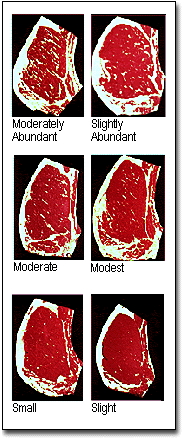| Choosing and Preparing a Perfect Steak
Selecting a Cut of Beef
High-quality fresh beef has the following characteristics: good texture,
sufficient marbling, desirable color, and lack of excess juices. The more
firm and fine the texture of the meat, the higher quality it is. A good
amount of marbling also indicates high-grade meat because it adds juiciness
and flavor. Beef is best in flavor and texture when cattle is between 18
and 24 months old. At this age, beef will have a rosy red color. (The characteristic
pink or red color of meat is due to myoglobin, a protein that contains
iron. The
amount of myoglobin varies with the age and species of the cattle.)
In order to make it easier for consumers to select quality meat and
be assured that they are getting their money’s worth, the United States
Department of Agriculture (USDA) has developed standards to grade beef.
USDA experts grade all meat before it is shipped from packing plants. They
stamp the grade on the meat with a harmless vegetable dye and use a roller
stamp so the grade will appear on all the principal cuts sold in stores.
Fresh beef is graded according to the following characteristics: conformation,
finish,
and overall quality. USDA grades take the guesswork out of buying quality
beef. There are seven USDA grades of fresh beef: Prime, Choice, Select,
Standard, Utility, Cutter, and Canner. The standards for each grade are
as follows:

|
-
USDA Prime: Beef of this grade is highly acceptable and palatable. The
cattle that produces this grade of meat is young and has had careful, intensive
feeding. Prime grade cuts have liberal marbling and are, therefore, juicy,
tender, and full of flavor. Loin steaks of this grade are exceptionally
tender.
-
USDA Choice: Because this grade is high-quality and has less fat than Prime
beef, it is the most popular among consumers. Choice beef is, therefore,
the most highly produced grade and the most abundantly available. Choice
roasts and steaks from the loin and rib are tender and juicy. Cuts from
the round or chuck are more suitable for braising and pot roasting. Choice
cuts should be tender with a well-developed flavor.
-
USDA Select: Beef of the Select grade has little fat and a high degree
of quality. Cuts of this grade lack the juiciness of higher grade meat
with more marbling. Many people prefer Select beef, however, because of
its tenderness and high proportion of lean to fat.
-
USDA Standard: Standard grade beef is lean and of an acceptable degree
of quality. It has a lesser degree of tenderness and flavor than the top
three grades. It is a good choice for thrifty consumers.
-
USDA Commercial: This grade of beef lacks the tenderness of higher grades
because it is produced from older animals. Most Commercial cuts require
long, slow cooking to make them tender and to develop the rich flavor of
mature beef. Cuts from such cattle have almost no marbling.
-
USDA Utility: Utility grade beef is produced from older cattle. It, therefore,
lacks natural tenderness and juiciness. Utility cuts carry very little
fat. They are good for pot roasting, stewing, boiling, and ground meat
dishes. Long, slow cooking is essential.
-
USDA Cutter and USDA Canner: The lowest USDA grades of meat are used in
processed meat products. They are not sold as cuts in stores.
|
Preparing a Steak
After choosing the desired cut and grade of beef, the consumer brings
it home. If the meat will be cooked within six hours of purchase, it may
be left in the package it came in. The object of safe meat storage is to
let air circulate and keep the meat’s surface somewhat dry, inhibiting
the growth of bacteria. If the meat will not be cooked until more than
six hours later, it should be unwrapped from the Styrofoam and plastic
wrap and stored wrapped loosely in wax paper in the coldest part of the
refrigerator. It can be stored for up to three days. It can also be wrapped
airtight and frozen for up to six months. To defrost a cut of beef, it
should be placed in the refrigerator or allowed to stand at room temperature
just until defrosted.
Cooking a Steak
Beef can be cooked in many ways, depending on the tenderness, size and
thickness of the cut. There are two basic types of heat -- dry (without
liquid) and moist (with steam or liquid).
-
Dry heat is used to cook more tender cuts while moist heat helps tenderize
tougher cuts. Methods of cooking with dry heat include roasting, broiling,
pan-broiling, sautéing (pan-frying), and rotisserie cooking.
-
Moist heat cooking methods include: braising, stewing, soup-making, and
pressure cooking. Because the filet mignon is one of the most tender cuts
in the carcass, it is cooked using dry heat. It is usually cooked quickly
by broiling, grilling, or sautéing. A slice of bacon is often wrapped
around the edge of a filet mignon steak to give it flavor.
The length of time that a steak is cooked affects how done it is
when served. Steaks can be cooked to three basic degrees: rare, medium,
and well done.
-
Beef that is cooked so that the middle is still quite pink is called rare.
It has the most flavor and juiciness, but is not entirely safe because
it has not been cooked long enough to kill all bacteria.
-
Medium beef is still a bit red in the middle but is cooked more fully than
rare steak. It has flavor and tenderness and is safe to eat.
-
Well-done steak is thoroughly cooked with no pink color left. It has less
flavor and tenderness than rare and medium steak, but is the safest to
eat.
|



